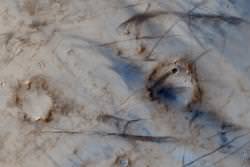The Martian atmosphere is tenuously thin; just 1% as thick as the Earth’s. And yet, it boasts a surprising array of weather systems, including clouds and global dust storms. The winds push dunes across the Martian surface and towering dust devils carve crisscrossed trails across the desolate landscape.
Here on Earth, wind, water and the slow movement of tectonic plates reshape the surface of our planet. On Mars, though, there’s not a drop of liquid water to be seen, and the planet’s plates seized up eons ago.
Only wind remains to rework the surface of the planet. But scientists wonder if the features we see on Mars today were formed recently by the blowing winds, or were created eons ago, when the winds and air pressure were much stronger.
Recent images from NASA’s Mars Reconnaissance Orbiter show various regions of Mars pushed around by winds.
“We’re seeing what look like smaller sand bedforms on the tops of larger dunes, and, when we zoom in more, a third set of bedforms topping those,” said HiRISE co-investigator Nathan Bridges of NASA’s Jet Propulsion Laboratory in Pasadena, Calif. “On Earth, small bedforms can form and change on time scales as short as a day.”
With the high-resolution HiRISE camera on MRO, scientists are able to see details for the first time. The images show sediments deposited on the downwind side of rocks. These windtails show where the most current winds have blown. When the winds change directions, the old windtails are obscured, and new ones are formed behind the rocks. This technique allows researchers to map wind directions across the entire planet.
Scientists have also discovered wind-scoured ridges called “yardangs”. The HiRISE images show their surface texture and fine-scale features to help explain how they form.
“HiRISE is showing us just how interesting layers in yardangs are,” Bridges said. “For example, we see one layer that appears to have rocks in it. You can actually see rocks in the layer, and if you look downslope, you can see rocks that we think have eroded out from that rocky layer above.”
And in the image attached with this story, you can see the paths taken by dust devils as they pass across the surface of Mars.
Original Source: NASA/HiRISE News Release


A fascinating story. I had a good look at Mars two nights ago through my telescope. I hope I live long enough to see humans travel to the Red Planet. The Martian rovers, Spirit and Opportunity are terrific, but I want to see boots on the ground.
I’m missing something. Why is this a story? We’ve seen the dust storms and dust devils. Clearly the answer to the heading is yes. It might not be the changes that volcanism leaves but you can’t have thousands of tonnes of dust in the atmosphere and hope that everything is going to be the same afterwards.
@ Peter: This is probably not a story for us Earthlings now, but may be one in the future for Martian farmers (as they would want to know this sort of info).
😉
@ Fraser: I wonder if Mars’s atmosphere was increased, would liquid water play a crucial role in its weather cycle?
That picture reminds me of a mystical cave painting!